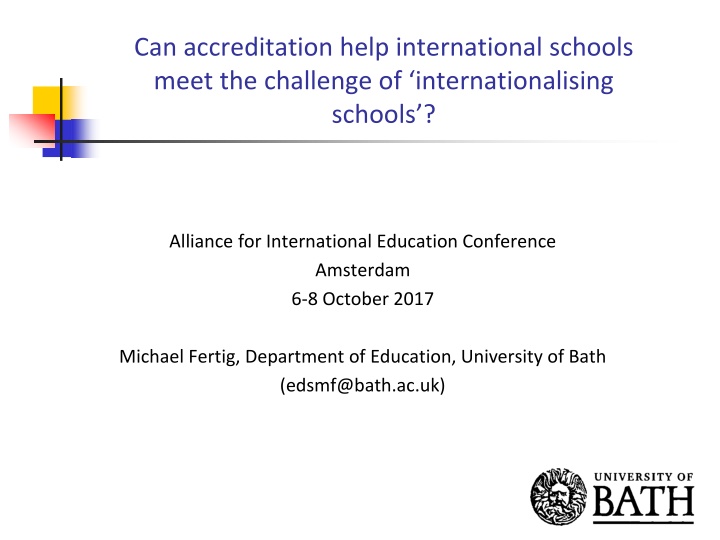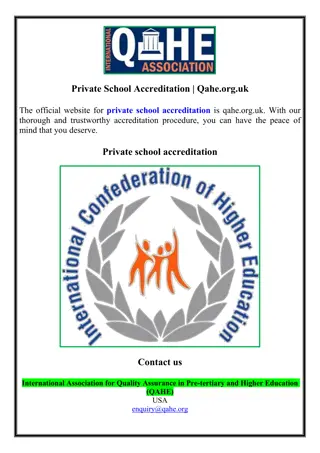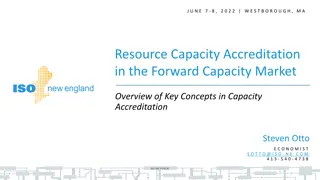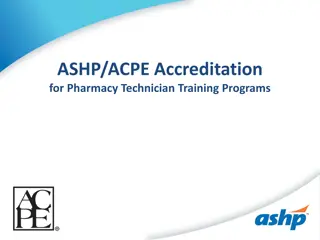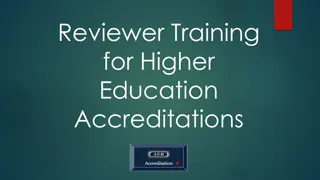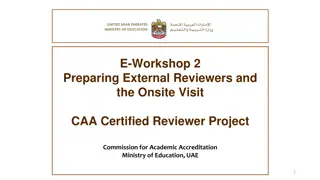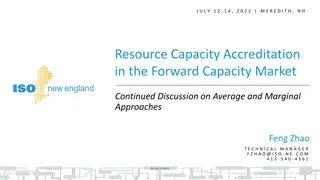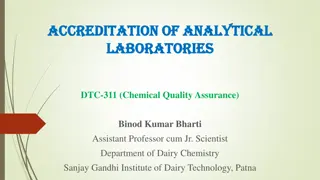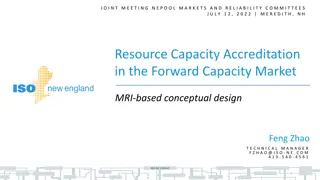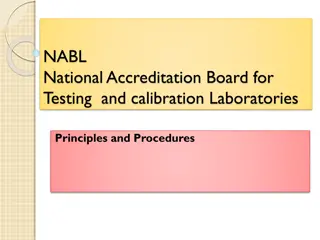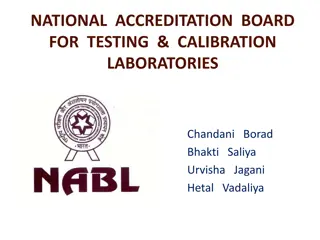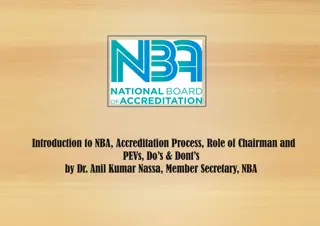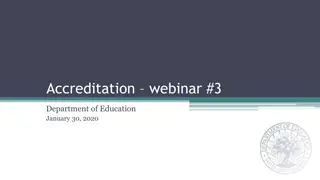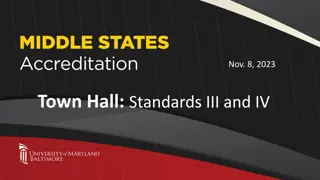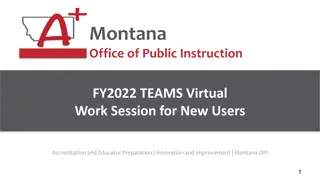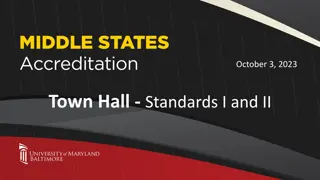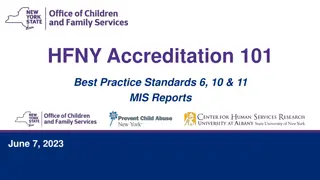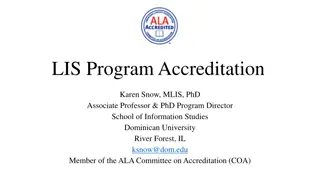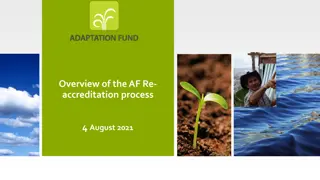Accreditation in International Education
Accreditation plays a crucial role in helping international schools meet the challenge of internationalizing education. It ensures academic standards are affirmed and quality learning experiences are provided to students. The process involves external assessment against established criteria, with successful programs receiving formal accreditation for a fixed term. This presentation explores the significance of accreditation in the context of international education, self-study processes, emerging issues, and standards to support the internationalization of schools.
Uploaded on Mar 13, 2025 | 1 Views
Download Presentation

Please find below an Image/Link to download the presentation.
The content on the website is provided AS IS for your information and personal use only. It may not be sold, licensed, or shared on other websites without obtaining consent from the author.If you encounter any issues during the download, it is possible that the publisher has removed the file from their server.
You are allowed to download the files provided on this website for personal or commercial use, subject to the condition that they are used lawfully. All files are the property of their respective owners.
The content on the website is provided AS IS for your information and personal use only. It may not be sold, licensed, or shared on other websites without obtaining consent from the author.
E N D
Presentation Transcript
Can accreditation help international schools meet the challenge of internationalising schools ? Alliance for International Education Conference Amsterdam 6-8 October 2017 Michael Fertig, Department of Education, University of Bath (edsmf@bath.ac.uk)
Overview internationalising schools what is accreditation ? the accreditation process self-study and emerging issues accreditation standards and emerging issues summary of key issues
What is meant by internationalising schools? having students from a number of different countries at the school? having teachers from a number of different countries at the school? including countries (eg those of students and/or teachers) other than the host country within the curriculum? giving students some form of direct experience of aspects of the culture of countries other than the host country (eg samosas and saris)? teaching a curriculum other than that of the host country? teaching in a language other than that of the host country?
Five pillars of International Education exposure to others of different cultures within the school teachers as exemplars of international mindedness exposure to others of different cultures outside the school a balanced formal curriculum a management regime whose values are consistent with an institutional international philosophy [Adapted from Thompson J. (1998) Towards a model for International Education in Hayden M. & Thompson J. (1998) International Education: Principles & Practice.]
Accreditation 1 By accreditation we mean a public and independent affirmation of the academic standards of (such) institutions, and of the quality of the learning experience of the students who attend them (Alderman & Brown, 2005, p 314). Accreditation is a mechanism whereby the educational program of an agency or educational institution is assessed by an external panel against established criteria. If it passes review, the program receives a formal document indicating that it is accredited usually for a fixed term period (McDavid & Huse, 2015, p 58).
Accreditation 2 a symbol of quality in education (Southern Association of Colleges and Schools, 2004, p1). Accreditation requires a public agency to voluntarily adopt a set of standards, policies, and practices that are sanctioned by a professional organization and then subject itself to scrutiny by a group of external reviewers (Teodoro & Hughes, 2012, p 583).
Accreditation 3 Accreditation can be seen as part of a developing evidence-based governance regime (Ehren et al, 2013, p 4) within institutions. This is characterised by: a setting of expectations for the performance of educational organisations, and a clearer communication of these expectations an increasing use of evaluation and accountability as key issues to ensure quality provision for all a belief that evidence from evaluation and accountability processes will stimulate institutional (and system) development and improvement.
Interest in Accreditation Google hits 2007 4,220,000 446,000 Sept 2017 97,400,000 381,000 accreditation school accreditation
Interest in Accreditation Google Scholar hits 2007 15,400 Sept 2017 35,400 accreditation in title school accreditation in title 106 243
Accredited Schools Council of International Schools, Accredited Schools, September 2017: 500 Council of International Schools, location of Accredited Schools, September 2017: 98 countries [Council of International Schools Membership Directory, available at www.cois.org/page.cfm?p=1884 accessed 11/09/17]
Accreditation Process the rock of self-study the hard place of standards
Self-study Accurate self-evaluation is a pre-condition for school improvement. Without it, leaders do not have a realistic view of their school s strengths and weaknesses (Knowledge & Human Development Authority, 2012, Inspection Handbook 2012- 2013, p 6). Self-evaluation as an iterative, reflexive and continuous process, embedded in the culture of the school is a highly effective means for a school to consolidate success and secure improvement across the full range of its activities (Children, Schools & Families Committee, 2010, para 53). The key contribution of inspection to improving educational provision is to supply well-founded information about the performance of schools that can be used to increase parental choice and bring about positive changes (Knowledge & Human Development Authority, 2012, Inspection Handbook 2012-2013, p 61).
Self-study: emerging issues 1 SAIS schools are asked to choose a method of evaluation that most closely aligns with the regular, on-going visioning or planning under way at the school A school can use any self study method generally recognized in the independent school world Choosing your own path is one of the distinctive features of the SAIS accreditation process (SAIS, 2013, p 17). The documentation requirement contributes to privileging a specific form of knowledge. It is a form of knowledge that insists that good professional practice is solely what can be documented as being good. The educational institution cannot be accredited if all of the required criteria for accreditation are not fully documented. According to the logic of the panopticon, quality has to be clearly visible (Engebretsen et al, 2012, p 411).
Self-study: emerging issues 2 In addition, accreditation requires the professional practitioner to ask new questions about the work he or she is doing. Do we have the documentation that we need? Have we written the report in the way that we are supposed to have done? Is the quality of our services in a format that can be measured? (Engebretsen et al, 2012, p 412).
Standards & Internationalising Schools Standard A3: The school s Guiding Statements endorse the school s commitment to developing inter-cultural learning Standard B6: The leadership of the school has the inter-cultural competencies, perspectives and appreciation needed for the school s unique cultural context Standard C3: The curriculum promotes the development of global citizenship and intercultural learning Standard D7: Teaching draws on appropriate cultural and authentic contexts to provide meaning to the students in their intercultural development. [Council of International Schools (2016) The Framework for the Evaluation & International Accreditation of Schools, pp 4/8/14/17]
Standards: Emerging Issues 1 ...highly structured organizational fields provide a context in which individual efforts to deal rationally with uncertainty and constraint often lead, in the aggregate, to homogeneity in structure, culture, and output (DiMaggio & Powell, 1983, p 147). Uncertainty is a powerful force that encourages imitation...Organizations tend to model themselves after similar organizations in their field that they perceive to be more legitimate or successful (DiMaggio & Powell, 1983, p 151-152). the development of quality assurance processes is interpreted as a tool that is used by the national states to ensure standardization and homogenization (Cret, 2011, p 420). Despite the emphasis on self-evaluation and autonomy involved in most quality assurance models, (they) contain the risk of encouraging compliance to that standard set of criteria and, hence, to uniformity and homogeneity (van Damme, 2000, p 15).
Standards: Emerging Issues 2 accreditors promise discretion to colleges in order to get the candid self-assessment necessary to improve these institutions As a result, virtually everything about accreditation continues to be shrouded in a veil of secrecy. Accreditation reports are kept secret, and the only information available to the public is whether an institution has or does not have accreditation (Gillen et al, 2010, p 14). Regulation occurs from the inside through the construction of auto-regulated or auto correcting selves (Freshwater et al, 2015, p 8). governmentality is a form of power that makes all surveillance redundant, because power has become internalized. Governmentality does not operate through surveillance but through motivation and stimulation and by making people work together for a goal and maximize their potential (Engebretsen et al, 2012, p 404).
Summary of key issues is an agreed view of internationalising schools possible? is an agreed view of internationalising schools desirable? can accrediting agencies encourage a particular view of internationalising schools ?
References and further reading Alderman G. & Brown R. (2005) Can Quality Assurance Survive the Market? Accreditation and Audit at the Crossroads . Higher Education Quarterly. Vol 59 No 4 pp 313-328. Children, Schools & Families Committee (2010) School Accountability. The Stationery Office, London. Council of International Schools (2016) The Framework for the Evaluation and International Accreditation of Schools. Council of International Schools, Petersfield. Cret B. (2011) Accreditation as local management tools . Higher Education. Vol 61 pp 415-429. van Damme D. (2000) Internationalization and quality assurance: towards worldwide accreditation . European Journal of Education Law & Policy. Vol 4 pp 1-20. DiMaggio P.J. & Powell W.W. (1983) The iron cage revisited: institutional isomorphism and collective rationality in organizational fields . American Sociological Review. Vol 48 pp 147-160. Ehren M.C.M., Altrichter H., McNamara G. & O Hara J. (2013) Impact of school inspections on improvement of schools describing assumptions on causal mechanisms in six European countries . Educational Assessment, Evaluation & Accountability. Vol 25 pp 3-43. EngebretsenE., Heggen K. & Ellertsen H.A. (2012) Accreditation and Power: A Discourse Analysis of a New Regime of Governance in Higher Education . Scandinavian Journal of Educational Research. Vol 56 No 4 pp 401-417. Fertig M. (2015) Quality Assurance in National and International Schools: Accreditation, Authorization and Inspection , in Hayden M., Levy J. & Thompson J. (eds) (2ndedition) The SAGE Handbook of Research in International Education, SAGE Publications Ltd, London, pp 447-463. Fertig M. (2007) International school accreditation: between a rock and a hard place? Journal of Research in International Education. Vol 6 No 3 pp 333-348. Freshwater D., Fisher P. & Walsh E. (2015) Revisiting the Panopticon: professional regulation, surveillance and sousveillance . Nursing Inquiry. Vol 22 No 1 pp 3-12. Gillen A., Bennett D.L. & Vedder R. (2010) The Inmates Running the Asylum? An Analysis of Higher Education Accreditation. Center for College Affordability & Productivity, Washington DC.
References and further reading Hayden M. & Thompson J.J. (1998) International Education: Principles and Practice. Kogan Page, London. Kay M. (2006) The effect of the New England Association of Schools & Colleges Accreditation process, including self-study, on teacher work activity. MA in Education Dissertation, University of Bath, Bath. van Kemenade E. & Hardjono T.W. (2010) A Critique of the Use of Self-evaluation in a Compulsory Accreditation System . Quality in Higher Education. Vol 16 No 3 pp 257-268. Knowledge & Human Development Authority (2012) Inspection Handbook 2012-2013. Knowledge & Human Development Authority, Dubai. McDavid J.C. & Huse I. (2015) How Does Accreditation Fit into the Picture? New Directions for Evaluation. Vol 145 pp 53-69. Meyer J.W. & Rowan B. (1977) Institutionalized Organizations: Formal Structures as Myth and Ceremony . American Journal of Sociology. Vol 83 No 2 pp 340-363. Ng P.T. (2010) The evolution and nature of school accountability in the Singapore education system . Educational Assessment, Evaluation & Accountability. Vol 22 pp 275-292. Park J. (2013) Detoxifying School Accountability. Demos, London. Southern Association of Colleges & Schools (2004) Benefits of Accreditation. SACS, Decatur, Georgia GA. Southern Association of Independent Schools (SAIS) (2013) Accreditation Guidebook. Atlanta, Georgia GA. StensakerB. (2008) Outcomes of quality assurance: a discussion of knowledge, methodology and validity . Quality in Higher Education. Vol 14 No 1 pp 3-13. Teodoro M.P. & Hughes A.G. (2012) Socializer or Signal? How Agency Accreditation Affects Organizational Culture . Public Administration Review. Vol 72 No 4 pp 583-591.
